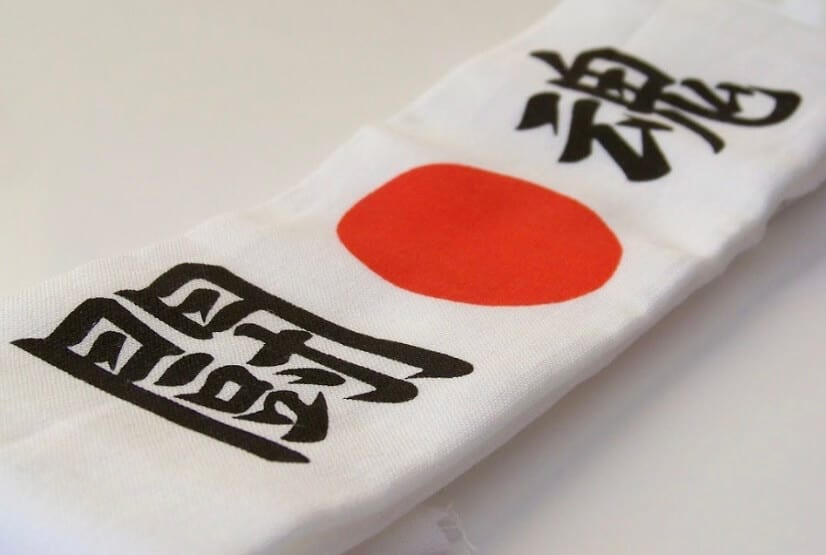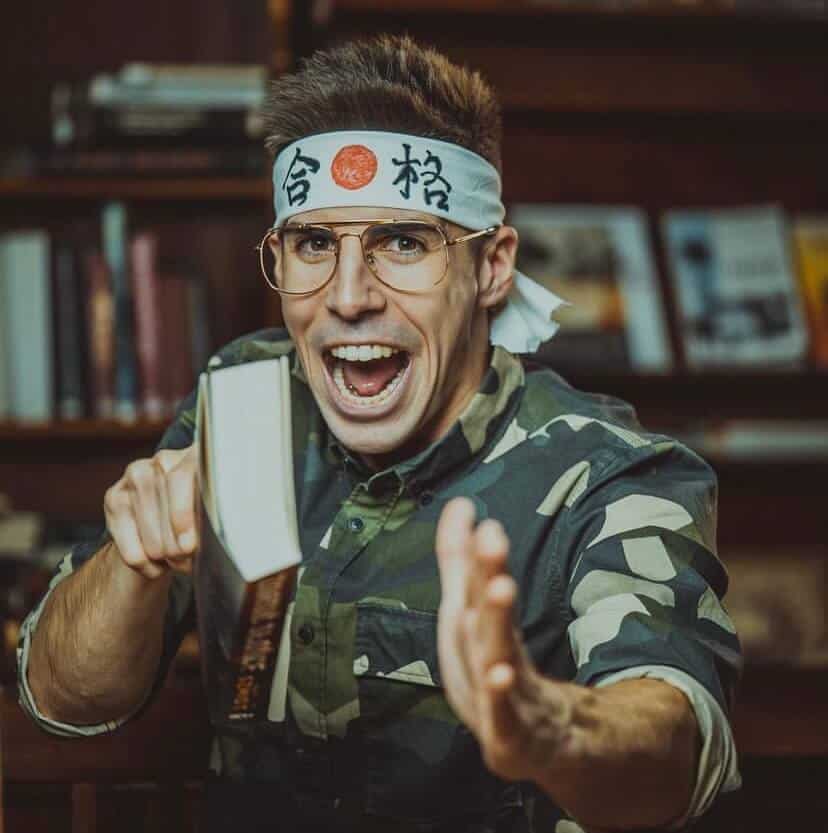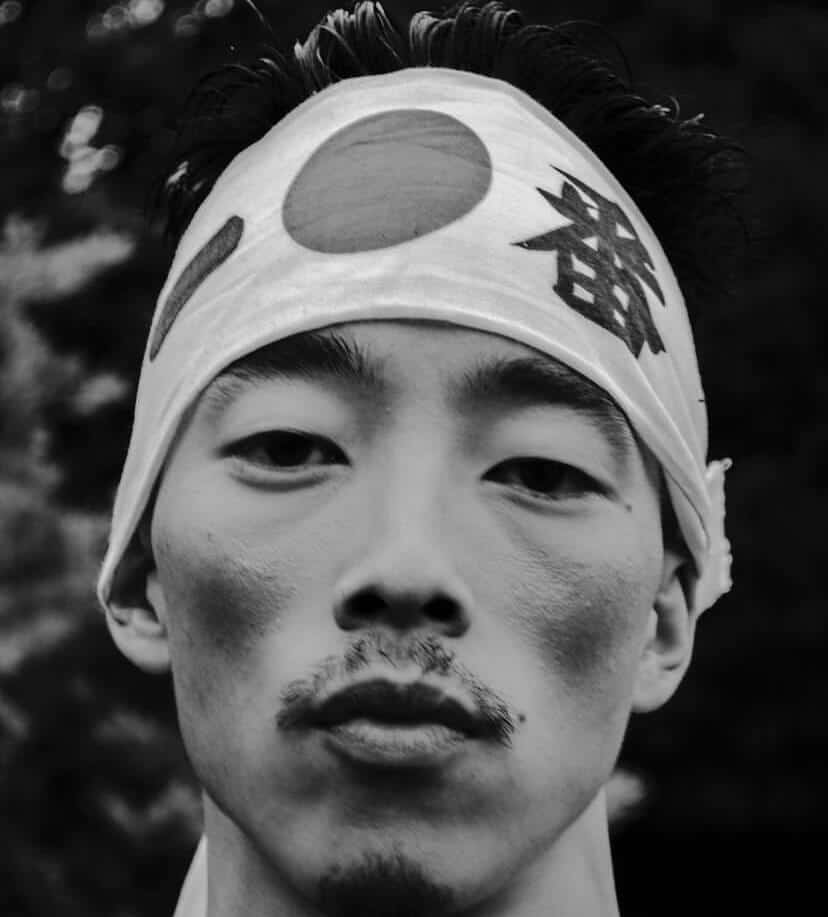What is a Hachimaki and why is it so important in Japanese culture? Find out all about this traditional headband and its significance in Japanese culture in this article.
What are some things that come to your mind when I say Japan? Is it sushi? Is it a ninja? Is it anime? Is it karate? Have you ever come across the term hachimaki – 鉢巻?
A hachimaki (鉢巻), or helmet-scarf is a modern and stylized headband or bandanna worn on a number of occasions in Japan.
The word hachimaki literally means ‘to wrap around the head’ and is made up of red and white fabric or cloth.
The origin of hachimaki is uncertain, but the leading theory says that it was needed for the samurai to wear this before placing their heavy helmets.
The cloth protected them from any injuries from the helmet and made the fit more comfortable.

In modern Japan, locals are seen wearing this with catchy slogans, usually with a red circle in the center similar to the Japanese flag.
Let us find out more about its significance, origin, designs, when to wear them and where you can buy them.
- Related: Traditional Japanese Footwear
- Related: Montsuki Traditional Costume For Men in Japan
Understanding The Real Meaning Of Hachimaki
The hachimaki symbolizes courage, perseverance, and effort. These are worn on numerous occasions and at traditional events.
For example, by sports spectators, students, women giving birth, or even office workers to increase motivation and show determination.
Alongside the kimono, the hachimaki is one of the regular items of clothing worn by Japanese people and could be worn by both men and women.
Even though the word means a helmet scarf which is quite a straightforward description as it was worn around the head like a helmet. In today’s fashion, the hachimaki can be compared to a modern bandana.
According to Japanese legend, the hachimaki strengthens the spirit and protects the one who wears it from evil spirits and demons.
It is believed that this trend began with the Samurai who wore these headbands underneath their helmets to absorb sweat, and to keep the helmets steady during wars and battles.
But with the Samurai being pretty much gone in modern society and swords being outlawed, when can you wear the Hachimaki in the present day?
Origin of the Hachimaki
There is no historical record that accurately shows the origin of this headband. However, there are several theories made by Japanese historians about where it comes from.
While one theory links it to religious ascetics in Japan, other theories suggest that the emergence was at the time of the samurai during the feudal era.
It was believed its original purpose was to keep the samurai’s helmet in place and was also used to absorb excess sweat and keep long hair in place, away from the eyes.
The hachimaki is also often associated with the ninja culture, where ninjas are seen wearing this headscarf.
The hachimaki is also a notable part of clothing items in Japanese history used during the Second World War.
Back then, it was used by kamikaze pilots as part of their military uniform and they would wear this band with the inscription of ‘Kamikaze’ written in kanji, or with the inscription ‘hisshou’ [必勝] or seven lives to indicate a sure win.
It was worn by these warriors on a crucial mission especially before flying to death.

This was the reason why they wore it during all the battles as a symbol of the spirit of war.
It was also used to protect and keep them safe, as the helmet used by them was uncomfortable and injured them while being worn directly on the head.
Because of the war, this headband ended up gaining worldwide fame which is the exact reason why even the samurai wore them.
Regardless of its origin, the hachimaki ended up becoming a great Japanese symbol and gained importance.
Hachimaki Designs
While anything can be drawn or written on this traditional headband, there are a few typical slogans or designs that are mostly associated with them.
This may depend upon the sort of event you may be attending. Below are a few different slogans you can use for common hachimaki designs-
- Ichi Ban (Number One)
- Nihon (Japan)
- Gokaku (Success)
- Kamikaze (Divine Wind)
- Hissho( Determined to win)
- Tookon (Fighting Spirit)
They are usually made from a strip of white or red fabric/ cloth which is approximately eight centimeters in length.
They may be worn flat against the forehead showing the Hinomaru Japanese flag design or kanji or it can be rolled into a cylindrical shape.
They can be also dyed using a special technique called Arashi shibori, or storm tie-dye which is similar to tie-dying, but the technique is slightly different.
Since wearing a hachimaki is believed to strengthen your spirit, it would be fit to wear it during a strenuous workout such as martial arts training or in a situation that will challenge your perseverance and determination.
For example, a student taking the entrance examination for college. Thus, wearing a hachimaki symbolizes a change in personality that you must make in order to accomplish a goal.
If you wish to make your very own authentic version of a hachimaki, you can easily do so by using a white or red cloth and cutting it into squares or strips of eight centimeters in length.
In the center, you can paint, draw or write your message, and then when it is done drying, just tie the ends into an X shape behind your head.
When To Wear A Hachimaki?
Even though the hachimaki originated during ancient Japanese culture, it does not mean that it is not popular among the present times.
The hachimaki is worn by both Japanese men and women on special occasions and is regarded as a symbol of strength, courage, and perseverance.
In modern times, the hachimaki is adorned with the rising sun motif, this is done to match the flag of Japan.
Some even put attractive and motivational slogans on his/her hachimaki. The most common slogan written or found is ‘Best Of Japan’ or ‘Nippon Ichi.’
As mentioned earlier in the article, there are many occasions that witness this headband across one’s head. Let us discuss that a little further:
Sporting Events and Occasions
A lot of Japanese martial arts like judo and taekwondo have used this as a part of the traditional ensemble as many athletes are commonly found wearing this headband during sport competitions.
Infact, the spectators and audience also wear it along with encouraging words to show support for their favorite athletes.
Workplaces and Schools
You will also see a lot of students and office workers wearing hachimaki since it signifies strength, effort, and perseverance, and will help an individual to get past a tough situation.
Political Events & Rallies
Since it is regarded as a symbol of strength, it is also used during rallies and political demonstrations. During rallies, it is very common for people to wear a hachimaki.
During Labor
In Japan, it is common for women who are in labor to wear this traditional headscarf while giving birth as a sign of courage.
Where Can You Buy A Hachimaki Today?
Anyone who wishes to buy a hachimaki in Japan please know it is not very hard to get one.
For whatever reason, either to keep as a symbol of strength or simply to have as a fun souvenir, you can get one very easily in Japan.
For starters, you can order online and many websites even allow you to customize your own hachimaki in a variety of ways.
You can choose from the colors-the traditional white, black or red, slogans, phrases, and so on.
There is a custom selection of phrases that you can choose for your hachimaki. A popular example is ‘Hissho’ in kanji, which translates into ‘Must Win!’
A single headband does not cost too much if you decide to shop online, one trustworthy shopping platform is through Amazon.
You can always opt to buy through physical stores as well. You can easily find at least one store in a commercial district that is selling this magnificent headscarf. This is the easiest option for tourists
Significance of HACHIMAKI: FAQS
What other situations can we see a hachimaki being worn?
The famous motorcycle gang can be seen wearing it called the bosozoku. It can be also used at decisive moments and to get courage and perseverance.
Conclusion
Western pop culture has taken its context a little bit out by portraying the wearer as some sort of martial artist.
A few notable examples would be the Karate kid or Kung Fu Panda. Although martial artists may wear a hachimaki while training, there are other kinds of people who may wear one too.
Today, even athletes and people who exercise can be seen wearing a hachimaki. Who would have thought that this simple act of wrapping a piece of cloth around the head could have such depth?
But like so many other things in Japan, even the simplest things have a much deeper meaning so hope you enjoyed this informative article.
Have you seen these bandanas and knew what they were? We appreciate your feedback and shares.







